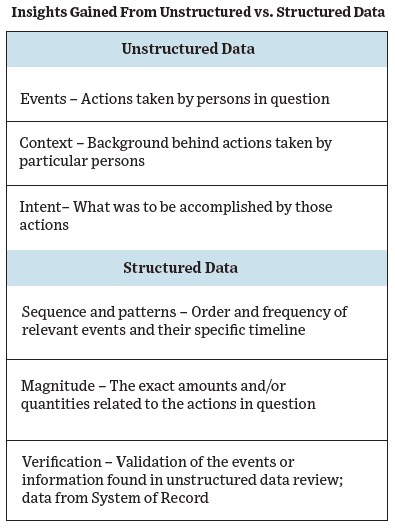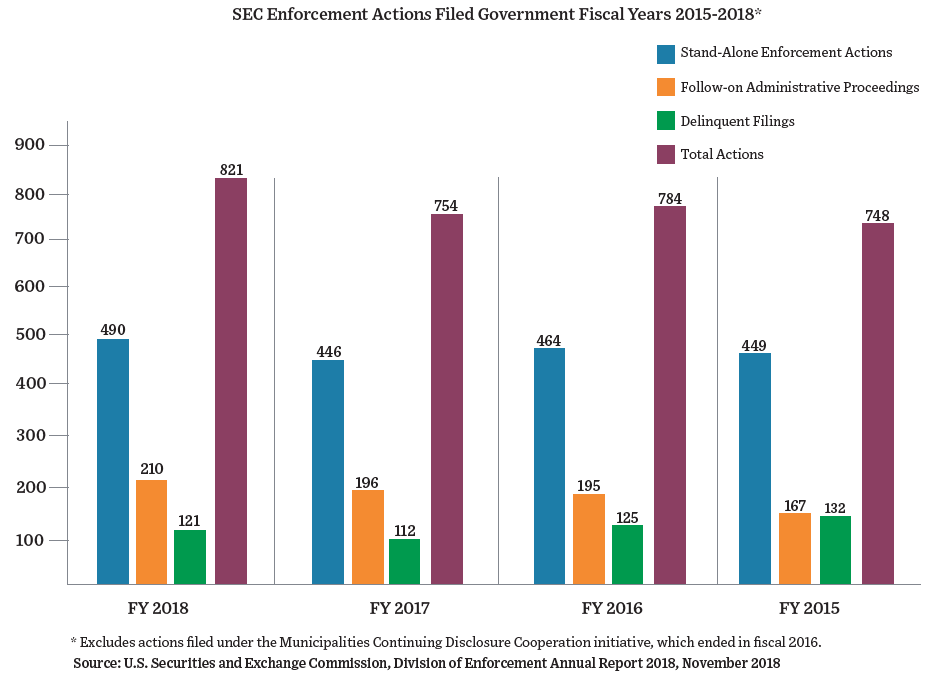According to the experts at AlixPartners, the tools needed to conduct the forensic investigations of tomorrow are very much available today.
It’s often said that the most effective way to conduct an investigation is to follow the money. When it comes to forensic investigations, we’d argue that the right approach in today’s world is to follow the data.
Forensic investigators are often the key to litigation and regulatory investigations as well as examining alleged wrongdoing, including money laundering issues, antitrust and competition disputes, financial reporting fraud and asset misappropriation. The traditional approach to forensic investigations typically involves independent teams reviewing separate data sets. Accountants examine financial records and databases, known as “structured data,” and look for evidence that will assist with legal review. Lawyers separately review “unstructured data” – emails, hard copy documents, chats, MS Word documents and PDFs – using the indicators defined on the forensic side to guide their investigation. Together, the unstructured and structured data provide the most complete picture of the events that have transpired. Unstructured data supplies qualitative insights and structured data uncovers quantitative evidence.

Technological and operational advances have made the traditional investigation approach more effective in recent years, but they haven’t kept pace with the explosion in data’s volume and complexity. In thinking about what data may be relevant to an investigation, it’s helpful to consider the following formula:
Number of Custodians x Data Sources x Volume of Collectible Data = Population of Usable Data
(We have included metrics from a recent matter to illustrate volumes.)

The total amount of usable data is then typically culled using a number of methodologies from analytics, email threading, date filters and search terms. The percentage of data culled will depend on the methodologies used, your time frame and for whom you need to produce data from your investigation (as well as their requirements). We have included the final numbers of the case above in order to provide context of how much data potentially can be produced. The culled set in this example resulted in a 110TB database.

The ability to quickly and seamlessly analyze different data sets is a game changer in investigations. The increase in the volume of data coupled with the growing number of data sources creates a complex
review process. Using the right technology, lawyers can accelerate obtaining key insights leading to the development of strategic considerations earlier in the investigative process.
—Danielle Corcione, Member of the firm Chiesa Shahinian & Giantomasi PC
In recent years, both the data sources and the volume of collectible data have increased exponentially. As an example, from data solutions provider Domo[1], per every minute of 2018:
- 159,362,760 emails were sent
- 12,986,111 texts were sent
- $3,541,666,666 was traded in the stock exchange
- 1,389 Uber rides were ordered
- 473,400 tweets were sent on Twitter
Given the vast amount of data now potentially relevant to a given case, forensic investigators face a trifecta of circumstances that cry out for tools to organize and analyze large-scale data in an integrated, cost-effective way:
- Companies are not only becoming more data intensive, they must also manage and archive huge amounts of data both to compete in the marketplace and to comply with federal and state regulations.
- The data that companies are using and storing is coming from an ever-rising number of sources that are increasingly interconnected. When combined with the immense quantity of data, this means that the level of data complexity is skyrocketing.
- The number and types of legal matters requiring forensic investigation are growing. As measured by SEC enforcement filings, the number of such legal matters hit a four-year high in 2018.

As people and organizations continue to rely on technology to conduct ordinary business, the amounts of structured and unstructured data will continue to multiply. And just as these data sources increase, the timelines and budgets within which we are expected to organize and make sense of these large data sets will continue to constrict. Utilizing technology in review makes the unmanageable more manageable by allowing efficiencies that would otherwise not be available, to review the vast amounts of data being preserved. There are advanced solutions available at every stage – collection, preservation, review, production – that have changed the way in which we conduct business. Software that helps us organize raw data upon collection makes our data review quicker and more efficient.
—Danielle Davidson, Litigation Technology Specialist, Ropes & Gray LLP
Moving forward
While the traditional approach remains the standard, there are other ways and – best of all – in-house counsel and their outside lawyers don’t have to wait for them until some point in the future. They exist now.
One solution is a state-of-the-art technology program, built into a leading forensic review tool, that can store and evaluate both structured and unstructured data. Centralizing both types of data in one holistic platform can create a much more complete picture of relevant events than previously possible, while yielding critical insights that otherwise may have gone undetected.
AlixPartners has used this technology for several years to help our clients achieve their investigative goals, preventing incomplete data collection and isolated and discrete review. It offers significant benefits:
- Deeper dive means greater efficiencies. Proprietary algorithms enable the program to triangulate data and develop deeper insights more quickly. In doing so, the program streamlines several layers of the traditional investigative process.
- Stronger, less challengeable cases. Integrating structured and unstructured data opens up new opportunities for building arguments – which can make legal cases stronger and less vulnerable to challenge. The connection of forensic dots yields significant facts, patterns and conclusions.
- Collaboration among investigative teams. The technology allows investigators to cut through the noise, deriving insights and strategy more quickly. This efficiency allows teams to respond to increasingly tight deadlines in a more timely and cost-effective manner, with increased cooperation and communication among the teams involved.
One of the biggest game-changers in legal tech has been the advance of technology assisted review. We can now leverage these platforms to review volumes of data that used to take months or years in a matter of days or weeks. Not only has this helped get through discovery more cost effectively, but we’ve also been able to leverage this tech in early case assessment efforts to discover important communications (emails, texts, and chats), or proactively analyze sales and trading data to identify patterns that may become relevant to a dispute. In the past, some of this discovery wouldn’t be feasible until later in a matter. But now we can get a more nuanced sense of issues early on, providing a potentially significant strategic advantage to the client.
—Peter Isajiw, Partner, King & Spalding LLP
The Future Is Now
Even as most forensic investigations continue to use the traditional approach, companies are embracing new technologies for a variety of investigation-related needs. According to our firm’s 2019 survey of more than 250 general counsel and compliance officers at large U.S. and European companies, over the past 12 months:
- 49 percent of those surveyed said that they’d boosted the implementation of new technology to reduce the risk of potential litigation.
- 48 percent said that their legal issues involved information technology and structured data services.
- 46 percent increased their leveraging of data and analytics to reduce litigation risk.
- 82 percent said that managing eDiscovery spending was an important issue.
- 92 percent said that information governance was an important issue.
Clearly, top corporate legal professionals are aware that advanced technological methods can address multiple business pursuits. That these and other functions may involve forensic investigation at some point should be just as clear.
The good news is that the tools to conduct the forensic investigation of the future aren’t languishing as items on a company’s or law firm’s wish list: They’re available in the present. The future, in other words, is now.
[1] Domo, Data Never Sleeps 6.0., June 2018.
Published March 8, 2019.






